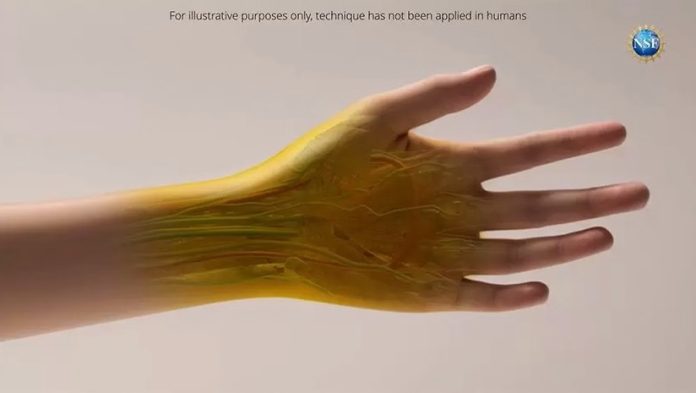
Researchers at Stanford University have developed a groundbreaking technique to make skin and other tissues transparent using a simple food-safe dye.
This new method, which temporarily renders tissues see-through, could revolutionize how doctors view and diagnose internal issues such as injuries, cancers, and digestive disorders.
The study, led by Stanford University assistant professor Guosong Hong and published in Science, uses FD & C Yellow 5 (also known as tartrazine), a common food dye, to achieve this transparency effect.
When applied to the skin, the dye allows visible light to pass through tissues that would normally block it, providing a clearer view of the organs beneath. This exciting technique could lead to better medical diagnostics, including easier blood draws, improved cancer detection, and even more precise laser-based treatments.
The process works by solving a common problem: our skin and other tissues appear opaque because they scatter light.
This scattering happens when light encounters fats, proteins, and fluids in our body, each of which has a different refractive index. The refractive index determines how much light bends as it moves through a material.
Since the body’s materials are tightly packed and have varying refractive indices, light gets scattered, making it difficult for us to see through tissues.
The Stanford researchers realized that by matching the refractive indices of different tissues, they could reduce scattering and allow light to travel straight through. They discovered that tartrazine, a food-safe dye, could absorb into tissues and align the refractive indices, making the tissue transparent.
The team first tested this on thin slices of chicken breast. As more dye was absorbed, the tissue became completely transparent. They then applied the dye to live mice, rubbing a tartrazine solution on the scalp to reveal blood vessels in the brain, and on the abdomen to show the movements of the intestines and heartbeat. In both cases, the tissue became transparent, allowing a clear view of the organs underneath.
The best part? The process is completely reversible.
Once the dye is washed off, the tissue quickly returns to its normal state. The researchers found no long-term effects, and any leftover dye was excreted from the body within 48 hours. This means the technique is safe for potential future use in humans.
Guosong Hong sees this technology being applied in a wide range of medical fields. “This technique could make veins easier to see for blood draws, simplify laser tattoo removal, and even help in early cancer detection,” said Hong. Currently, some laser treatments are limited to areas close to the surface of the skin because the light can’t penetrate deeper. This new method could improve light penetration, allowing lasers to treat deeper tissues.
The researchers believe that by injecting the dye into the body, they could achieve even deeper views, potentially helping doctors diagnose and monitor conditions without invasive surgery.
The project began as an exploration of how light interacts with tissues, but quickly expanded into a larger collaboration, involving 21 researchers. Using an ellipsometer, a tool typically used in semiconductor manufacturing, they measured how different dyes affect light behavior. Postdoctoral researcher Zihao Ou, who led the study, tested various strong dyes to find the ideal one, with tartrazine emerging as the most effective.
This breakthrough in transparency technology could open up a whole new field of study, where scientists match specific dyes to different tissues to create better medical imaging tools.
The research was supported by various organizations, including the U.S. National Science Foundation (NSF), the National Institutes of Health, and the U.S. Air Force Office of Scientific Research. Hong credits NSF for playing a key role in the success of the project, providing critical funding during the pandemic, which allowed the team to continue exploring these new technologies.
This discovery marks a major step forward in non-invasive medical diagnostics, providing a new window into the body that could lead to better treatments and outcomes for patients.
Source: National Science Foundation.



